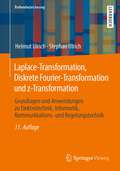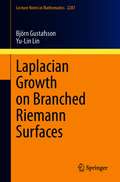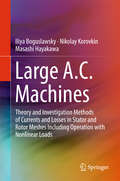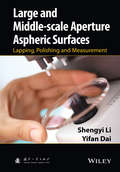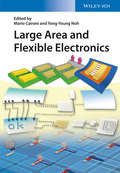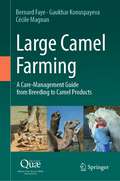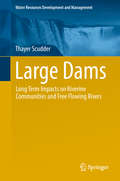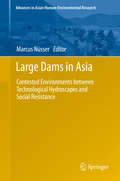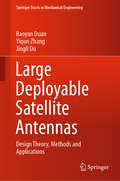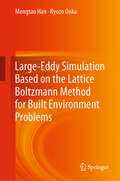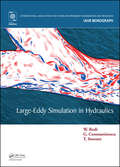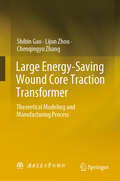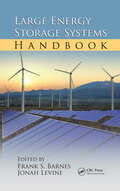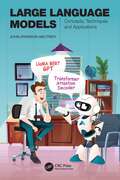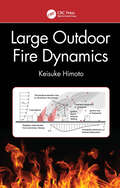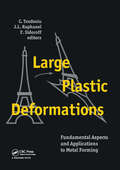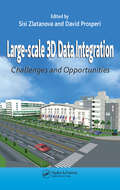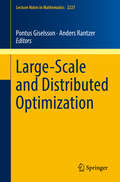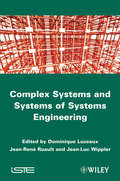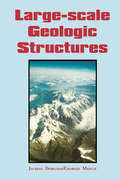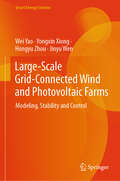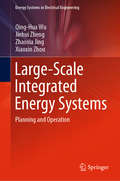- Table View
- List View
Laplace-Transformation, Diskrete Fourier-Transformation und z-Transformation: Grundlagen und Anwendungen zu Elektrotechnik, Informatik, Kommunikations- und Regelungstechnik
by Helmut Ulrich Stephan UlrichDieses Buch ist eine leicht verständliche Einführung in die Theorie und praktische Handhabung der Laplace-, Fourier- und z-Transformation, die in vielen Fachgebieten wie der Elektrotechnik , Informations- und Kommunikationstechnik, Mechatronik, Regelungstechnik etc. eine wichtige Rolle spielen. Zahlreiche Beispiele und Anwendungen zeigen den richtigen Umgang mit den Transformationen. Die Erläuterungen werden vielfach durch graphische Darstellungen veranschaulicht. Das Ziel des Buches ist es, eigene Problemstellungen mit den gezeigten Methoden erfolgreich angehen zu können. Die didaktische Aufbereitung des Lehrstoffes im Buch sichert einen nachhaltigen Lernerfolg .
Laplacian Growth on Branched Riemann Surfaces (Lecture Notes in Mathematics #2287)
by Björn Gustafsson Yu-Lin LinThis book studies solutions of the Polubarinova–Galin and Löwner–Kufarev equations, which describe the evolution of a viscous fluid (Hele-Shaw) blob, after the time when these solutions have lost their physical meaning due to loss of univalence of the mapping function involved. When the mapping function is no longer locally univalent interesting phase transitions take place, leading to structural changes in the data of the solution, for example new zeros and poles in the case of rational maps. This topic intersects with several areas, including mathematical physics, potential theory and complex analysis. The text will be valuable to researchers and doctoral students interested in fluid dynamics, integrable systems, and conformal field theory.
Large A.C. Machines
by Iliya Boguslawsky Nikolay Korovkin Masashi HayakawaIn this monograph the authors solve the modern scientific problems connected with A. C. motors and generators, based first on the detailed consideration of their physical phenomena. The authors describe the theory and investigative methods they developed and applied in practice, which are considered to be of essential interest for specialists in the field of the electrical engineering industry in European countries, the USA, Argentina, and Brazil, as well as in such countries as India, China, and Iran. This book will be of interest to engineers specialized in the field of the manufacture, operation, and repair of A. C. machines (motors and generators) as well as electric drives; to professors, lecturers, and post-graduate students of technical universities, who are specializing in the field of electric machine engineering and electric drives; and to students who are engaged in the field of high current techniques, electric drives, and electric machine engineering.
Large and Middle-scale Aperture Aspheric Surfaces: Lapping, Polishing and Measurement
by Shengyi Li Yifan DaiA complete all-in-one reference to aspheric fabrication and testing for optical applications This book provides a detailed introduction to the manufacturing and measurement technologies in aspheric fabrication. For each technology, both basic theory and practical applications are introduced. The book consists of two parts. In the first part, the basic principles of manufacturing technology for aspheric surfaces and key theory for deterministic subaperture polishing of aspheric surfaces are discussed. Then key techniques for high precision figuring such as CCOS with small polishing pad, IBF and MRF, are introduced, including the basic principles, theories and applications, mathematical modeling methods, machine design and process parameter selection. It also includes engineering practices and experimental results, based on the three kinds of polishing tools (CCOS, IBF and MRF) developed by the author’s research team. In the second part, basic principles of measurement and some typical examples for large and middle-scale aspheric surfaces are discussed. Then, according to the demands of low cost, high accuracy and in-situ measurement methods in the manufacturing process, three kinds of technologies are introduced, such as the Cartesian and swing-arm polar coordinate profilometer, the sub-aperture stitching interferometer and the phase retrieval method based on diffraction principle. Some key techniques are also discussed, including the basic principles, mathematical modeling methods, machine design and process parameter selection, as well as engineering practices and experimental results. Finally, the team’s research results about subsurface quality measurement and guarantee methods are also described. This book can be used as a reference for scientists and technologists working in optical manufacturing, ultra-precision machining, precision instruments and measurement, and other precision engineering fields. A complete all-in-one reference to aspheric fabrication and testing for optical applications Presents the latest research findings from the author’s internationally recognized leading team who are at the cutting edge of the technology Brings together surface processing and measurement in one complete volume, discussing problems and solutions Guides the reader from an introductory overview through to more advanced and sophisticated techniques of metrology and manufacturing, suitable for the student and the industry professional
Large Area and Flexible Electronics
by Yong-Young Noh Mario CaironiFrom materials to applications, this ready reference covers the entire value chain from fundamentals via processing right up to devices, presenting different approaches to large-area electronics, thus enabling readers to compare materials, properties and performance.Divided into two parts, the first focuses on the materials used for the electronic functionality, covering organic and inorganic semiconductors, including vacuum and solution-processed metal-oxide semiconductors, nanomembranes and nanocrystals, as well as conductors and insulators. The second part reviews the devices and applications of large-area electronics, including flexible and ultra-high-resolution displays, light-emitting transistors, organic and inorganic photovoltaics, large-area imagers and sensors, non-volatile memories and radio-frequency identification tags.With its academic and industrial viewpoints, this volume provides in-depth knowledge for experienced researchers while also serving as a first-stop resource for those entering the field.
Large Camel Farming: A Care-Management Guide from Breeding to Camel Products
by Bernard Faye Gaukhar Konuspayeva Cécile MagnanThis practical guide is intended for all actors in the sector who work with large camelids, whether in breeding, technical advice or veterinary care. It successively describes the general aspects of the species, the physiological bases of reproduction, lactation and feeding, the main production processes, and health and hygiene management in camel breeding. Chapters on slaughter, important camel products and their processing complete the volume.Large camels (camels and Bactrian camels) are domestic animals that are increasingly used in Western countries, as well as in Africa and Asia, for tourism, sport, and production of milk, meat, and wool. In addition, camel husbandry systems are changing, taking a greater share of sedentary systems, specializing in breeding, and intensifying production. At the same time, many veterinarians and breeders are not familiar with the animal, its needs, physiology, diseases, and management, which is often based on practices introduced for cattle and proving ineffective.This work is a practical aid for all interested readers who want to embark on the adventure of working with large camelids in a cultural context where they are not yet a dominant element of the agricultural landscape. The numerous photographs and drawings that support the text make it a unique and entertaining read.
Large Dams: Dealing With The Social, Environmental And Political Costs (Water Resources Development and Management)
by Thayer ScudderThis book highlights the first comparative long-term analysis of the negative impacts of large dams on riverine communities and on free-flowing rivers in Africa, the Middle East and Asia. Following the Foreword by Professor Asit K. Biswas, the first section covers the 1956–1973 period, when the author believed that large dams provided an exceptional opportunity for integrated river basin development. In turn, the second section (1976–1997) reflects the author’s increasing concerns about the magnitude of the socio-economic and environmental costs of large dams, while the third (1998–2018) discusses why large dams are in fact not cost-effective in the long term.
Large Dams in Asia
by Marcus NüsserThis book explores the multi-dimensional asymmetries of scale, time, and directions in the large dam controversy with a regional focus on Asia, especially on India and China. Whereas the concept of large-scale transformation of fluvial environments into technological hydroscapes originated in the West, widespread construction of large dams started in the countries of the Global South in the period after decolonisation. Construction and operation of large dams are amongst the most prestigious but also most sensitive development issues, often accompanied by massive resistance of adversely affected people and civil society organisations. Based on the notion of a contested politicised environment, various case studies are analysed to identify the dominant narratives and imaginations that shape the large dams debate. This volume largely contains contributions related to several subprojects from within the Cluster of Excellence 'Asia and Europe in a Global Context: Shifting Asymmetries in Cultural Flows', based at Heidelberg University, with several expert contributions from external researchers.
Large Deployable Satellite Antennas: Design Theory, Methods and Applications (Springer Tracts in Mechanical Engineering)
by Baoyan Duan Yiqun Zhang Jingli DuThis book discusses the innovative design, cable-net design and analysis, control, deployment, development and applications of large space-deployable antennas. Drawing on the authors’ own work in this field, it describes and analyzes various typical deployable antennas, membrane antennas and super-large space-assembled antennas, while chiefly focusing on mesh antennas due to their wide range of applications. It also investigates forming–finding design and the analysis of cable-truss structures for high-precision reflector antennas, as well as deployment process control and deployment reliability based on flexible multibody dynamic analysis. The book covers not only mechanical structure performance, but also electromagnetic performance realization and stability. Lastly, it proposes an electrical equivalent method for mesh reflector antennas and a coupling model for the structural displacement field and electrostatic field. Given the nature of its content, the book is intended for researchers, graduate students and engineers in the field of space antennas.
Large-Eddy Simulation Based on the Lattice Boltzmann Method for Built Environment Problems
by Mengtao Han Ryozo OokaThis book details the lattice Boltzmann method (LBM) applied to the built environment problems. It provides the fundamental theoretical knowledge and specific implementation methods of LBM from the engineering perspective of the built environment. It covers comprehensive issues of built environment with three detailed cases, solving practical problems. It can be used as a reference book for teachers, students, and engineering technicians to study LBM and conduct architecture and urban wind environments simulations, in the fields of architecture, building technology science, urban planning, HVAC, built environment engineering, and civil engineering.
Large-Eddy Simulation in Hydraulics
by Wolfgang Rodi George Constantinescu Thorsten StoesserAn introduction to the Large-Eddy-Simulation (LES) method, geared primarily toward hydraulic and environmental engineers, the book covers special features of flows in water bodies and summarizes the experience gained with LES for calculating such flows. It can also be a valuable entry to the subject of LES for researchers and students in all fields of fluids engineering, and the applications part will be useful to researchers interested in the physics of flows governed by the dynamics of coherent structures.
Large Energy-Saving Wound Core Traction Transformer: Theoretical Modeling and Manufacturing Process
by Shibin Gao Lijun Zhou Chenqingyu ZhangThis book delves into the innovative realm of wound core transformers designed for high-voltage power grids, moving beyond the traditional laminated core structures prone to magnetic flux leakage and energy dissipation. Through a novel enclosed wound core design that eliminates joints and corners, it presents a transformative approach that minimizes leakage and enhances the electromagnetic performance of transformers. This book not only addresses the technical challenges and solutions in transformer design but also marks a significant step forward in the pursuit of energy efficiency and performance optimization in electrical power systems. Targeting a specialized audience of professors, scholars, and graduate students engaged in transformer energy-saving optimization and related research fields, it offers an in-depth exploration of the complete loss calculation, innovative manufacturing processes, and testing technologies of large-scale wound core transformers.
Large Energy Storage Systems Handbook (Mechanical and Aerospace Engineering Series)
by Frank S. Barnes Jonah G. LevineIn the current push to convert to renewable sources of energy, many issues raised years ago on the economics and the difficulties of siting energy storage are once again being raised today. When large amounts of wind, solar, and other renewable energy sources are added to existing electrical grids, efficient and manageable energy storage becomes a
Large Floating Structures
by C. M. Wang B. T. WangThis book surveys key projects that have seen the construction of large floating structures or have attained detailed conceptual designs. This compilation of key floating structures in a single volume captures the innovative features that mark the technological advances made in this field of engineering and will provide a useful reference for ideas, analysis, design and construction of these unique and emerging urban projects to offshore and marine engineers, urban planners, architects and students.
Large Language Models: Concepts, Techniques and Applications
by John Atkinson-AbutridyThis book serves as an introduction to the science and applications of Large Language Models (LLMs). You'll discover the common thread that drives some of the most revolutionary recent applications of artificial intelligence (AI): from conversational systems like ChatGPT or BARD, to machine translation, summary generation, question answering, and much more.At the heart of these innovative applications is a powerful and rapidly evolving discipline, natural language processing (NLP). For more than 60 years, research in this science has been focused on enabling machines to efficiently understand and generate human language. The secrets behind these technological advances lie in LLMs, whose power lies in their ability to capture complex patterns and learn contextual representations of language. How do these LLMs work? What are the available models and how are they evaluated? This book will help you answer these and many other questions. With a technical but accessible introduction: You will explore the fascinating world of LLMs, from its foundations to its most powerful applications You will learn how to build your own simple applications with some of the LLMs Designed to guide you step by step, with six chapters combining theory and practice, along with exercises in Python on the Colab platform, you will master the secrets of LLMs and their application in NLP.From deep neural networks and attention mechanisms, to the most relevant LLMs such as BERT, GPT-4, LLaMA, Palm-2 and Falcon, this book guides you through the most important achievements in NLP. Not only will you learn the benchmarks used to evaluate the capabilities of these models, but you will also gain the skill to create your own NLP applications. It will be of great value to professionals, researchers and students within AI, data science and beyond.
Large MIMO Systems
by A. ChockalingamLarge MIMO systems, with tens to hundreds of antennas, are a promising emerging communication technology. This book provides a unique overview of this technology, covering the opportunities, engineering challenges, solutions, and state-of-the-art of large MIMO test beds. There is in-depth coverage of algorithms for large MIMO signal processing, based on meta-heuristics, belief propagation and Monte Carlo sampling techniques, and suited for large MIMO signal detection, precoding, and LDPC code designs. The book also covers the training requirement and channel estimation approaches in large-scale point-to-point and multi-user MIMO systems; spatial modulation is also included. Issues like pilot contamination and base station cooperation in multi-cell operation are addressed. A detailed exposition of MIMO channel models, large MIMO channel sounding measurements in the past and present, and large MIMO test beds is also presented. An ideal resource for academic researchers, next generation wireless system designers and developers, and practitioners in wireless communications.
Large Outdoor Fire Dynamics
by Keisuke HimotoLarge Outdoor Fire Dynamics provides the essential knowledge for the hazard evaluation of large outdoor fires, including wildland, WUI (wildland-urban interface), and urban fires. The spread of outdoor fires can be viewed as a successive occurrence of physical and chemical processes – solid fuel combustion, heat transfer to surrounding combustibles, and ignition of heated combustibles – which are explained herein. Engineering equations frequently used in practical hazard analyses are derived and then integrated to implement a computational code predicting fire spread among discretely distributed combustibles. This code facilitates learning the procedure of hazard evaluation for large outdoor fires. Chapters cover underlying assumptions for analyzing fire spread behavior in large outdoor fires, namely, wind conditions near the ground surface and fundamentals of heat transfer; the physical mechanism of fire spread in and between combustibles, specifically focusing on fire plumes (both reacting and non-reacting) and firebrand dispersal; and the spatial modeling of 3D objects and developing the computational framework for predicting fire spread. The book is ideal for engineers, researchers, and graduate students in fire safety as well as mechanical engineering, civil engineering, disaster management, safety engineering, and planning. Companion source codes are available online.
Large Plastic Deformations: Proceedings of the international seminar MECAMAT'91, Fontainebleau, France, 7-9 August 1991
by C.TEODOSIU; J.L.RAPHANEL; F.SIDOROFFThis volume covers topics involving large plastic deformation of metallic materials. These proceedings offer an overview of the synergism achieved by combining microstructural characterization and understanding, mechanical modelling and experiments, numerical analysis and computation.
Large-scale 3D Data Integration: Challenges and Opportunities
by Sisi Zlatanova David ProsperiLarge-Scale 3D Data Integration: Challenges and Opportunities examines the fundamental aspects of 3D geo-information, focusing on the latest developments in 3D GIS (geographic information) and AEC (architecture, engineering, construction) systems. This book addresses policy makers, designers and engineers, and individuals that need to overco
Large-Scale and Distributed Optimization (Lecture Notes in Mathematics #2227)
by Pontus Giselsson Anders RantzerThis book presents tools and methods for large-scale and distributed optimization. Since many methods in "Big Data" fields rely on solving large-scale optimization problems, often in distributed fashion, this topic has over the last decade emerged to become very important. As well as specific coverage of this active research field, the book serves as a powerful source of information for practitioners as well as theoreticians.Large-Scale and Distributed Optimization is a unique combination of contributions from leading experts in the field, who were speakers at the LCCC Focus Period on Large-Scale and Distributed Optimization, held in Lund, 14th–16th June 2017. A source of information and innovative ideas for current and future research, this book will appeal to researchers, academics, and students who are interested in large-scale optimization.
Large-scale Complex System and Systems of Systems
by Dominique Luzeaux Jean-René Ruault Jean-Luc WipplerWith the growing maturity of information and communication technologies, systems have been interconnected within growing networks, yielding new services through a combination of the system functionalities. This leads to an increasing complexity that has to be managed in order to take advantage of these system integrations. This book provides key answers as to how such systems of systems can be engineered and how their complexity can be mastered. After reviewing some definitions on systems of systems engineering, the book focuses on concrete applications and offers a survey of the activities and techniques that allow engineering of complex systems and systems of systems. Case studies, ranging from emergency situations such as Hurricane Katrina and its crisis management or a generic scenario of a major traffic accident and its emergency response, to the establishment of a scientific basis in the Antarctic region illustrate key factors of success and traps to avoid in order to cope with such situations.
Large-Scale Construction Project Management: Understanding Legal and Contract Requirements
by Yan TanA majority of large-scale construction and major infrastructure projects are funded by public funds from taxpayers. However, these projects are often subject to severe delays and cost overruns. Large-Scale Construction Project Management: Understanding Legal and Contract Requirements introduces integrated approaches to project management and control mechanisms to effectively manage large-scale construction projects. It explains the contractual requirements and associated legal principles under the latest edition of the leading standard forms of contracts, including FIDIC 2017, NEC4, and JCT 2016. It explains integrated project governance regarding time, cost, risk, change, contract management, and more. Further, it discusses the legal issues of scheduling delays and disruptions regarding the Delay and Disruption Protocol (Society of Construction Law) as well as Forensic Schedule Analysis guidance (American Association of Cost Engineering). Features: Provides strategies to effectively resolve disputes during construction projects Examines Quantitative Schedule Risk Analysis (QSRA) and Quantitative Cost Risk Analysis (QCRA) Introduces the most recent software and techniques used in managing large-scale construction projects This book serves as a useful resource for project control and management professionals, researchers in construction management and project management, and students in building construction management and project management.
Large-Scale Geologic Structures
by Jacques Debelmas Georges MascleThis text is a translation of "Les Grandes Structures Geologiques", Paris 1997. It is devoted to the study of major geological features such as oceanic ridges, continental margins, sedimentary basins and mountain chains.
Large-Scale Grid-Connected Wind and Photovoltaic Farms: Modeling, Stability and Control (Smart Energy Systems)
by Hongyu Zhou Wei Yao Yongxin Xiong Jinyu WenThis book provides a comprehensive study of the modeling, analysis, and control of wind farms and solar power stations. It starts with dynamic vector modeling methods for wind farms and solar power stations, which enhance modeling efficiency and model accuracy. Building upon this modeling framework, it also covers stability analysis and control methods for wind farms and solar power stations from both steady-state and transient perspectives. Lastly, considering the integration of energy storage into renewable energy power stations, the book explores the analysis and control of wind-energy storage and solar-energy storage hybrid systems. It adopts a holistic approach, establishing a fundamental framework for the topic, progressing from modeling to analysis and then to control, facilitating readers' comprehension. The book is targeted towards undergraduate and graduate students interested in renewable energy power stations, researchers focusing on station-level modeling, analysis, and control of renewable energy, as well as engineers in the field.
Large-Scale Integrated Energy Systems: Planning and Operation (Energy Systems in Electrical Engineering)
by Qing-Hua Wu Jiehui Zheng Zhaoxia Jing Xiaoxin ZhouThis book discusses key issues in the planning and operation of large-scale integrated energy systems (LSIES). It establishes individual-based models for LSIES and develops multi-objective optimization algorithms and multi-attribute decision making support systems, which are applied to the planning and optimal operation of LSIES. It is a valuable reference work for researchers, students and engineers who are interested in energy systems, operation research and decision theory.
